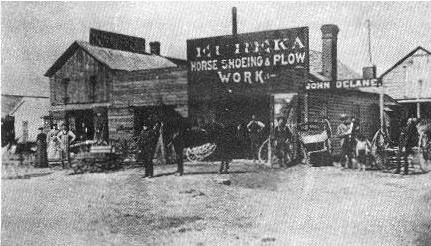|
HISTORY OF BLACKSMITHING
Longfellow wrote - "Under the spreading chestnut tree, the village smithy stands . . . " A staunch pillar of the community, respected and admired by all, was the smith of our forefathers.
The ancient and venerable craft of blacksmithing lifted man from the stone age. One of the oldest references is in the Scriptures: Genesis, Chapter 4, Verse 22: "Tubal Cain, an instructor of every artificer in brass and iron." In the history of the blacksmiths' art no period was richer in inventive fancy than that of the Middle Ages. The European smiths had a thorough understanding of the technicalities of iron. During this period of the Middle Ages, both the form and artistic workmanship of iron smithing was brought to perfection. Even the common domestic items such as the homely gridiron and the pot hook could compare with the elaborate hinge on a church door. Even a nail head was a thing of beauty.
The medieval smith made the chain-mail for the soldiers of the Crusades, the term "mail" means hammered. All the weapons of war - armor, swords, maces, battle axes, etc., were handiwork of the Smith. These were made entirely with the hammer and anvil, the pieces welded and riveted by manual labor of the smith. The finishing work of engraving, chasing and punching was also done by hand. Examples of the elaborate art of smithing can be found in the 12th and 13th century churches of Europe - from the intricate detail of the door plates, hinges, knockers, to the window grilles and railings, to the yard fences and gates on the church grounds.
On thru history the smith plied his skills with metals. Anchors for the sailing ships of Columbus; smiths forged the chain across, the Hudson River to block the British fleet; George Washington retired his troops to the "Valley of the Forges" to repair his arms and equipment; -- events which shaped the history of the United States.
Many great men of history practiced the smithing trade. All of our tools, machines, engines and horseless carriages originated in the blacksmith shop. Mr. Studebaker was a blacksmith, then a wagon maker, and in the early 1900's he started building autos and trucks. Many specific trades or crafts have evolved from the basic blacksmith skills of yesteryear.  |



